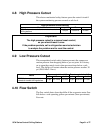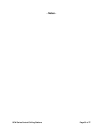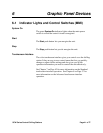Page 38 of 77 SCW Series Central Chilling Stations
2. Connect a refrigerant gauge to the suction service valve.
Fully front seat the service valve and open one full turn.
3. Bump start the compressor by switching off then on
quickly 0.5 to 1 second. If the rotation is correct, the
suction pressure will drop immediately. A rise in pressure
will indicate the wrong rotation. If this occurs, change over
two electrical phases of the incoming power supply (do not
change phase at the compressor starter).
Note:
• Never switch contactor leads or motor leads for reversing
rotation.
• Do not use contactor or motor leads for phase matching.
• Compressor damage will occur if the compressor is run in
reverse. The compressor motor protector checks for correct
phasing and will not allow it to start in reverse.
• If you discover that compressor rotation is reversed, correct it
by switching any two main power leads into the disconnect
switch or distribution block on the unit.
; Open the 1” (approx. 25 mm) makeup water valve and allow
the tank to fill until the automatic float valve shuts off. The
float level should be adjusted so the standing water level is 8”
(20 cm) from the top of the tank.
; Check for proper pump rotation direction. To confirm proper
rotation:
1. Observe a pump pressure gauge connected to the suction
and discharge sides of the pump casing through two ¼”
(approx. 6.4 mm) gauge cocks.
2. Close the gauge cock leading to the pump suction and open
the gauge cock leading to the pump discharge.
3. Close the discharge butterfly valve, crack it open, then start
the pump and observe the gauge.
• If the gauge indicates within 15 psi (103.4 kPa/1.03 bars)
below the pump curve, pump rotation is correct. Pump
rotation is clockwise opposite the shaft end.
• If the gauge indicates 20 psi (137.9 kPa/1.38 bars) or more
below the pump curve, the pump is running backwards.
Reverse rotation by interchanging any two power mains to
the pump motor or starter.
• Recheck the pressure to be sure it increased.


















